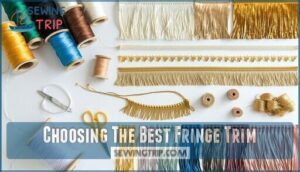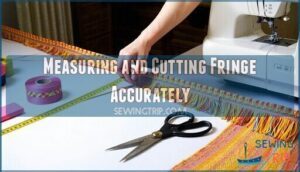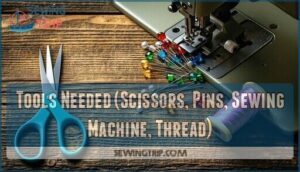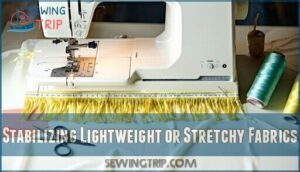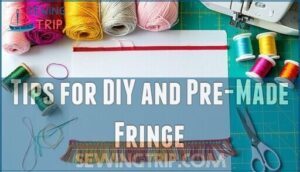This site is supported by our readers. We may earn a commission, at no cost to you, if you purchase through links.
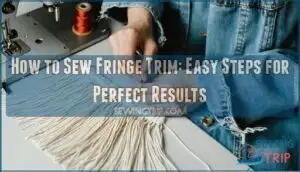
You’ll want to secure the fringe’s header tape with zigzag stitching to prevent fraying while allowing natural movement.
Pin your fringe carefully along the fabric edge, ensuring even distribution before stitching. For stretchy fabrics, use flexible chainette fringe to prevent puckering.
Hand stitching delivers invisible, couture-quality finishes, while machine topstitching adds durability to high-wear areas.
The key is keeping those delicate strands from tangling during application – a trick that makes all the difference in achieving that professional swaying motion.
Table Of Contents
Key Takeaways
- Match fringe weight to your fabric – You’ll get professional results when you pair lightweight chainette fringe with delicate materials like silk, while heavy bullion fringe works best on sturdy fabrics like denim.
- Secure the header tape with zigzag stitching – This prevents fraying while allowing natural movement, and you should pin the fringe evenly along your fabric edge before stitching to ensure proper distribution.
- Keep strands from tangling during application – You’ll achieve that smooth, professional swaying motion by working slowly and separating strands as you sew, especially through thick areas.
- Choose the right attachment method for your project – Hand stitching gives you invisible, couture-quality finishes for delicate work, while machine topstitching adds durability to high-wear areas like jacket edges.
Why Sewing on Fringe Trim Matters
You’ll transform ordinary projects into eye-catching pieces when you learn to sew fringe trim properly.
This simple technique adds professional movement and texture that makes garments, home decor, and accessories stand out from basic designs, giving them a unique and professional look.
Versatility for Garments and Home Decor
Whether you’re updating dance costumes or renovating living spaces, fringe trim transforms ordinary projects into showstoppers.
This versatile trim elevates everything from garments to home decor with distinctive texture effects.
Popular applications include:
- Garments – Dance outfits, scarves, skirts, shawls, and jackets benefit from movement-enhancing fringe styles
- Home Decor – Pillows, lampshades, and table linens gain visual interest through strategic trim options
- Accessories – Bags and throws showcase fabric choices while following current decor trends
Personalization and Creative Expression
Adding your personal touch to sewing fringe transforms basic projects into signature pieces.
You control everything from Fringe Styles to Color Choices, making each creation uniquely yours.
| Creative Element | Customization Options |
|---|---|
| Fabric Selection | Cotton, silk, metallic threads |
| Trim Options | Beaded, chainette, bullion styles |
| Color Choices | Contrasting or matching palettes |
| Creative Embellishments | Sequins, pearls, mixed textures |
Sewing fringe gives you complete creative control over your decorative trim choices, letting you experiment with different sewing techniques and fabric trim combinations for truly personalized results.
Added Movement and Texture
Fringe transforms static fabric into dynamic art that catches light and moves with every gesture. This decorative trim creates visual interest through layered textures and rhythmic motion that draws the eye naturally.
Transform any project into movement and magic with fringe trim’s dancing textures
Here’s how fringe adds life to your projects:
- Creates fluid movement – Each strand dances independently, making garments flow gracefully with body motion
- Builds dimensional texture – Multiple strand layers create depth that flat fabric simply can’t match
- Catches and reflects light – Moving fringe creates shifting shadows and highlights that change with perspective
Different fringe styles offer unique movement effects. Chainette fringe provides gentle swaying motion, while brush fringe creates fuller, more dramatic movement. Your fabric choices determine how the trim behaves – lightweight materials allow maximum flow, while heavier fabrics create controlled, structured movement.
These trim details transform ordinary sewing projects into eye-catching pieces that command attention through their inherent motion and rich textural depth. Understanding fabric texture options is essential for selecting the right materials to complement fringe trim and achieve the desired movement and texture in your sewing projects.
Selecting The Right Fringe for Projects
Getting your fringe selection right makes the difference between amateur and professional results.
Match trim weight to your fabric—lightweight chainette fringe works beautifully on silk scarves, while sturdy bullion fringe handles denim jackets.
Consider your project’s purpose and washing requirements when choosing materials.
| Fabric Type | Best Fringe Styles | Key Considerations |
|---|---|---|
| Lightweight (silk, chiffon) | Chainette, beaded | Delicate attachment needed |
| Medium weight (cotton, linen) | Brush, loop, bullion | Versatile trim options |
| Heavy fabrics (denim, canvas) | Thick bullion, leather | Requires sturdy stitching |
| Stretch knits | Flexible chainette | Match stretch properties |
How to Sew Fringe Trim Step by Step
Ready to master the art of fringe attachment? The secret lies in proper preparation and methodical execution that transforms any project from basic to brilliant.
- Plan your fringe patterns by marking placement lines with washable chalk before cutting
- Test your sewing tools on fabric scraps to guarantee proper tension and stitch quality
- Pre-treat trim length by sealing cut edges to prevent unraveling during construction
Start your fabric prep by stabilizing lightweight materials with interfacing where fringe will attach. Position the decorative heading along your marked line, ensuring even distribution.
When you sew fringe trim, align the trim’s bound edge with your fabric’s raw edge, right sides together. Use a straight stitch or narrow zigzag, maintaining 2.5-3mm stitch length for maximum security.
For sewing fringe that requires precision, employ a walking foot on heavy fabrics. Hand-baste tricky curves before machine stitching.
Complete your edge finishing with a second row of topstitching above the attachment seam. This fringe sewing tips approach prevents lifting during wear. Remember: patience during fringe trim sewing yields professional results that’ll make you proud.
When working with corners, remember to fold ribbons diagonally for a smooth finish.
Choosing The Best Fringe Trim
Selecting the right fringe trim determines whether your project looks professionally finished or falls flat.
You’ll want to take into account the fringe type, fabric compatibility, and maintenance requirements before making your final choice.
Types of Fringe (Chainette, Bullion, Brush, Loop, Beaded)
Understanding your options helps you pick the perfect match for your project.
The right fringe choice makes all the difference between amateur and professional results
Chainette durability shines in dance costumes with its fluid drape, while bullion application works best for formal drapery with heavy twisted cords.
Brush density creates polished edges on garments, loop creation adds playful texture through embroidery thread loops, and beaded variations offer sparkle for evening wear when you sew fringe trim carefully.
You can even explore options to create DIY fringe trims for a customized look and use fringe trim to enhance your project with a perfect match.
Durability and Wash Friendliness
When selecting fringe trim, consider how it’ll hold up after multiple washes. Synthetic materials like polyester outperform natural fibers, maintaining their appearance for 30+ machine cycles. Cotton fringes show significant fraying after just 10 washes.
- Fringe reinforcement: Double-stitch attachment points using heavy-duty polyester thread for superior washing techniques resilience
- Material selection: Choose UV-treated synthetics for better fringe durability and color retention during frequent fringe laundering
- Repair strategies: Apply fray check to cut ends before washing quilts or garments to prevent unraveling during drying methods
Smart fringe preservation starts with proper material selection and secure attachment methods for long-lasting fringe care.
Matching Fringe to Fabric Weight
Proper fabric weight matching prevents fringe from overwhelming delicate materials or appearing too flimsy on heavy fabrics.
Your fringe weight guide should balance drape and density—lightweight fabrics like silk need fine chainette trim, while heavyweight fabrics like denim handle substantial brush fringe.
When sewing fringe trim, fabric type pairing guarantees professional results and prevents sagging or puckering at seams.
Consider how texture adds dimension to the overall design.
Avoiding Delicate or High-Maintenance Trims
Skip delicate beaded or silk fringes that demand hand-washing and special care.
Choose durable fringe types like cotton chainette or synthetic brush trims instead. These washable trim options survive regular machine cycles without shedding or tangling.
Low-maintenance materials mean you’ll actually use your finished pieces instead of babying them. Practical fringe choices save time when sewing fringe trim later.
Preparing Fringe and Materials
Before you start stitching, you’ll need to gather the right tools and prepare your fringe properly.
Taking time to measure accurately and stabilize your fabric will save you from headaches later and guarantee your fringe hangs beautifully. Measure accurately and stabilize your fabric.
Measuring and Cutting Fringe Accurately
Measuring your fringe trim correctly saves time and prevents costly mistakes.
Start by measuring the project’s perimeter, then add 2-3 inches for overlap at seams.
Mark fringe length with tailor’s chalk, ensuring consistent width throughout.
When cutting, use sharp fabric scissors for clean edges that won’t fray.
Check accurate measurement twice before cutting to maintain professional results.
Proper technique relies on straight grain importance for consistent results and to ensure a clean edge that is visually appealing.
Tools Needed (Scissors, Pins, Sewing Machine, Thread)
You’ll need sharp fabric scissors for clean cuts, quality pins to secure fringe without snagging, and a reliable sewing machine with adjustable settings.
Choose thread weight that matches your fabric—heavier thread for thick materials, lighter for delicate ones.
Keep your sewing tools maintained; dull scissors create frayed edges that’ll haunt your project.
Investing in specialized sewing implements can substantially improve your results, ensuring your fringe trim attaches smoothly without wrestling stubborn materials.
Stabilizing Lightweight or Stretchy Fabrics
Lightweight fabrics like chiffon or stretchy knits need extra support when you sew fringe trim.
Apply fusible interfacing or cut-away stabilizer to prevent puckering and distortion during stitching.
Test your stitch settings and tension adjustments on fabric scraps first, to ensure a smooth process.
This simple step transforms wobbly results into professional-looking trim attachment that won’t warp or pull, making it a crucial part of the sewing process for a successful outcome.
Tips for DIY and Pre-Made Fringe
Pre-made fringe offers convenience and professional finishing, while DIY fringe provides unlimited customization options.
When comparing costs, DIY materials like embroidery thread cost less but require time investment. Pre-made selection guarantees consistent durability and saves hours of preparation.
Consider your project timeline—DIY fringe works great for unique colors, but pre-made trims deliver reliable results when you need to sew fringe trim quickly. Exploring options for crafting fringe yourself can provide cost-effective solutions.
Sewing Techniques and Care Tips
Once you’ve mastered the attachment process, proper care becomes essential for maintaining your fringe’s appearance and durability.
Hand-washing or using a delicate cycle prevents damage, while proper storage techniques guarantee your fringed items look fresh for years to come.
Attaching Fringe With Machine or Hand Stitching
With proper sewing techniques, you’ll transform basic fabric into stunning creations.
Machine sewing offers speed and consistency, while hand stitching provides precision for delicate work. Your choice depends on the project’s requirements and your comfort level.
One can further refine their skills through understanding essential hand stitches.
- Zigzag stitching prevents fraying and allows natural movement of chainette fringe
- Hand stitching delivers invisible results perfect for couture-quality finishes
- Topstitching fringe adds durability to high-wear areas like jacket edges
- Securing strands individually prevents future unraveling and maintains appearance
- Continuous effect across seams creates professional, seamless trim application
Securing and Finishing Edges Neatly
Once you’ve secured your fringe trim, focus on creating clean, professional finishes.
Concealed raw edges prevent fraying and give your project that polished look. Overlapping seams at corners guarantees continuous coverage without gaps.
| Technique | Method | Result |
|---|---|---|
| Concealed Raw Edges | Fold under 1/4 inch before stitching | Clean, professional appearance |
| Overlapping Seams | Overlap ends by 1/2 inch at side seams | Seamless continuous effect |
| Topstitching Security | Add second row 1/8 inch above attachment | Extra durability for heavy use |
Hand-sewn finishes work best for delicate trims, while topstitching security handles heavy-duty applications.
Apply fray prevention products to cut edges before sewing – this simple step saves headaches later when your beautiful fringe starts unraveling.
Washing and Drying Fringed Items Safely
Hand washing fringed items in cold water protects delicate fibers from damage.
Use a gentle detergent and avoid aggressive scrubbing that tangles strands.
Bundle fringe with hair ties before washing to prevent knots.
Choose the delicate cycle for machine washing, always placing items in mesh laundry bags.
Skip the dryer entirely—air dry flat, separating strands for proper fringe drying and lasting wash friendliness to ensure the delicate fibers are protected.
Repair, Maintenance, and Storage Recommendations
Regular fringe maintenance keeps your projects looking fresh.
Inspect trim monthly for tangled strands or frayed ends.
Comb gently with fingers to prevent matting.
Trim damaged sections with sharp scissors for clean edges.
Store fringed items flat or rolled in acid-free tissue paper.
Keep them away from direct sunlight and moisture.
Apply fray prevention gel sparingly to problem areas for extended fringe longevity.
Frequently Asked Questions (FAQs)
Where can I buy fringe trim?
You’ll find fringe trim at fabric stores like OnlineFabricStore, Trims by the Yard, and Mood Fabrics.
Amazon offers extensive selections, while local craft stores typically stock basic varieties for immediate pickup.
What are the different types of fringe trimming?
You’ll encounter chainette, beaded, bullion, brush, and looped fringe as the most common types.
Chainette features twisted cord construction, while beaded versions incorporate decorative elements.
Bullion uses wrapped cord, brush offers full texture, and looped creates dimensional effects.
What is a fringe on a dress?
A fringe on your dress is a decorative border of loose threads, cords, or tassels that adds movement and texture.
You’ll find it enhancing hemlines, sleeves, or necklines, creating dynamic visual interest that transforms ordinary garments into eye-catching statement pieces.
Can I sew fringe trim by hand?
Machine stitching offers speed and consistency, while hand sewing provides complete control over delicate beaded fringes.
You’ll use slip or whip stitches for precision.
Choose thread slightly darker than your fabric for seamless blending.
How do I choose the right thread color?
Choose thread that’s slightly darker than your fabric for the best blend.
This trick creates seamless integration—lighter threads tend to stand out awkwardly against most materials, while darker shades disappear into the weave naturally.
What sewing machine settings are best for fringe?
Like ye olde seamstresses mastering their craft, you’ll need strategic settings for success.
Use a straight stitch with 5-3mm length for stability.
Choose a zigzag stitch for reinforcement on heavier trims.
A walking foot helps with thick materials like leather.
Can fringe trim be added to curved edges?
Yes, you can add fringe trim to curved edges, though it requires patience and precision.
Ease the fringe around curves by clipping the heading at intervals, stretching gently, and sewing slowly to prevent puckering.
How do I repair damaged fringe trim?
Damaged fringe got you down?
First, comb out tangles gently with your fingers or wide-tooth comb.
Trim frayed ends with sharp scissors, then apply fray-preventing gel to seal edges and restore that perfect drape.
Can fringe be sewn on curved seams?
Perfectly placed curves meet fringe’s flexibility—you’ll discover that curved seams actually work better than straight ones.
Use sharp pins every inch, ease the trim gently around curves, and stitch slowly with precision for professional results.
How do you prevent fringe from tangling?
Brush fringe gently with your fingers or wide-tooth comb while sewing to prevent tangling. Keep strands separated and work slowly through thick areas for smooth results.
Conclusion
Ironically, mastering how to sew fringe trim requires slowing down to achieve that effortless, flowing movement.
You’ve learned that matching fringe weight to fabric, securing header tape properly, and preventing tangles during application create professional results.
Whether you choose hand stitching for invisible finishes or machine topstitching for durability, careful preparation prevents frustration later.
With practice, you’ll confidently add this dynamic embellishment to garments and home decor projects with consistent, beautiful outcomes.

